| Model 1842 Preußen Infantry Landwehr Pickelhaube |
| |
The "Grandfather" of all Pickelhaubes; an issued Model 1842 Preußen Infantry Mannschaften (Other Ranks) Landwehr Pickelhaube.
The brass eagle Wappen (front plate), spike and base, front visor trim, rear spine, and chinscales, are fitted to an exceptionally tall helmet shell made from boiled leather with a distinctive squared front visor which flares out at the sides. As is typical for an issued helmet, this helmet has had a varied career. It appears that it was originally issued in 1842 to a Line Infantry Regiment, re-fitted sometime after 1843 with a new eagle Wappen, eventually issued to the Landwehr or Reserve, and finally fitted with a Model metal Preußen Kokarde in 1857.
As the Pickelhaube evolved, older Model 1842 helmets were cut down and re-sewn to comply with the new regulations. M1842 were converted to M1857, then converted again to M1860, then once again to M1867 etc. This policy of modifying older models to new regulations explains the extreme rarity of issued M1842 Pickelhaubes today.
| 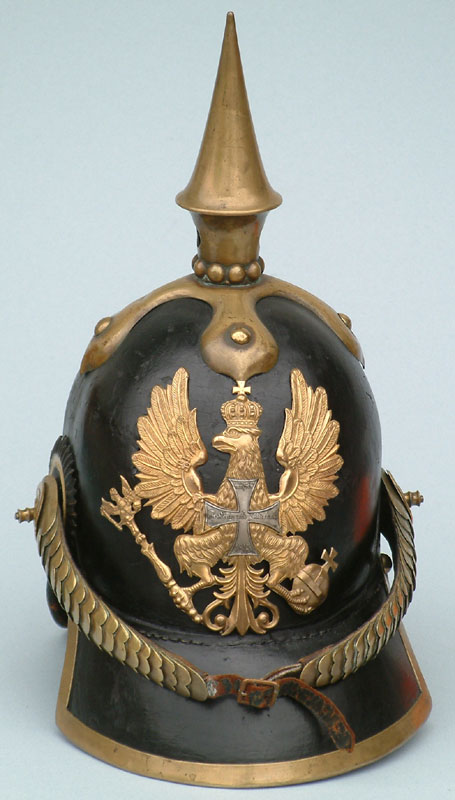 |
|
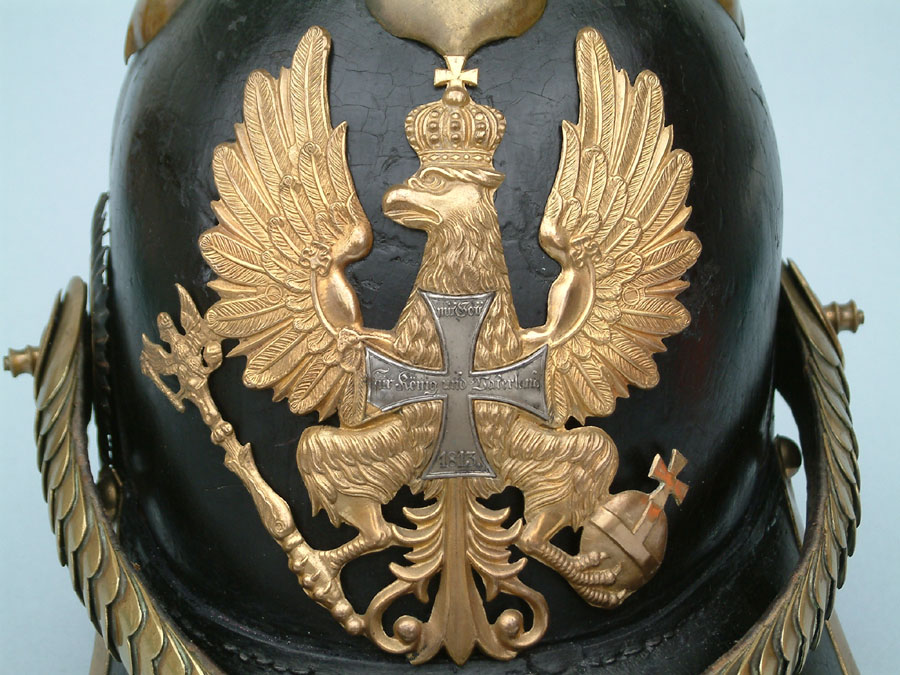 |
| |
The line eagle Wappen (front plate) measures 125mm and mimics the shape and pattern of the Royal Preußen scepter. Rather than having the standard "FR" or "FWR" on the eagle's chest for most troops, this Landwehr or Reserve Wappen carries a silver Landwehr Iron Cross.
Note that on this early Wappen all tail feathers drop vertically below the chest and that the gaps between the wings and the legs are not voided.
Holes under the Wappen reveal that this Pickelhaube carried the original M1842 Wappen which was secured by two bolts that passed through the wings of the eagle Wappen. In 1843 two threaded bolts were soldered to the reverse of newer eagle Wappen which required new holes in the front of the helmet shell. |
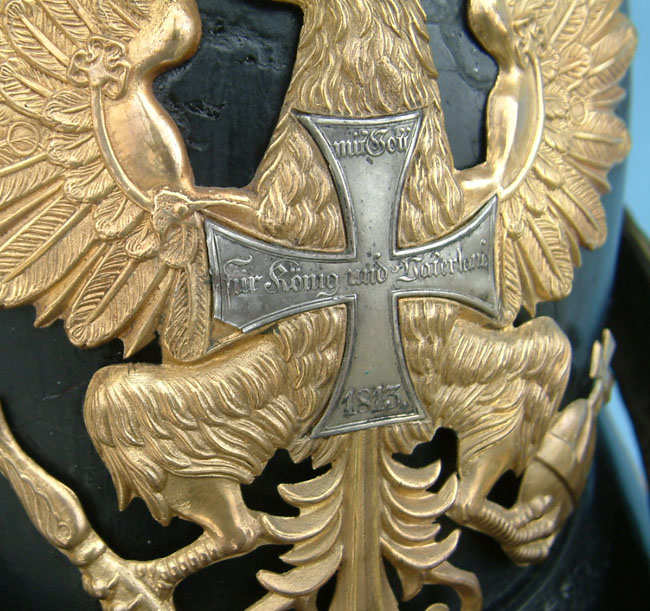 | A small corner of the 1813 Landwehr Iron Cross on this example has broken off which is typical as metal from this era tends to be quite brittle. |
|
 |
| |
A view of the Model 1842 Preußen Infantry Mannschaften (Other Ranks) Landwehr Pickelhaube profile. The height of this helmet is shown nicely in this photograph.
Sitting on a flat surface, the helmet measures an incredible 38cm tall (15 inches) tall.
The helmet would have originally been issued with a 75mm leather Preußen Kokarde in the national colors of black/white/black, however, this example carries the massive 75mm metal Preußen Kokarde introduced in 1857; probably added when the helmet was issued to the Landwehr or Reserve. |
The helmet spike is an amazing 14 cm tall and rests on a cruciform spike base which slopes sharply down to follow the contour of the shell. For ventilation, two holes in the neck of the spike can be closed by rotating the brass decorative "Perlring" (literally, a ring of pearls) at the bottom.
The spike top is not removable, as removable spike tops were not introduced for specific Regiments until 1857. | 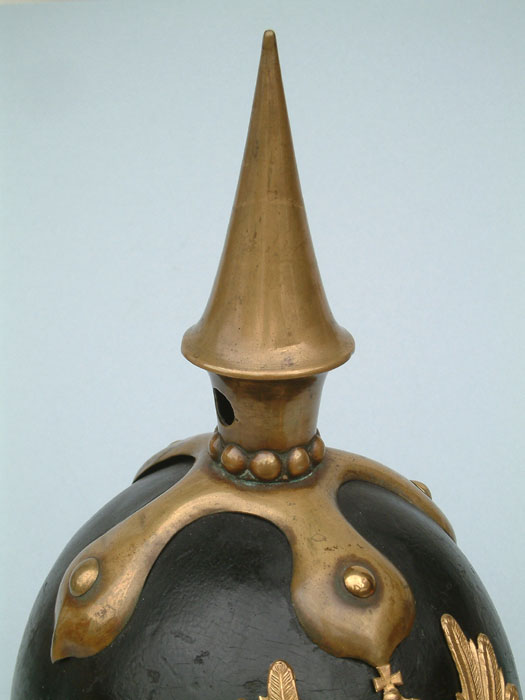 |
|
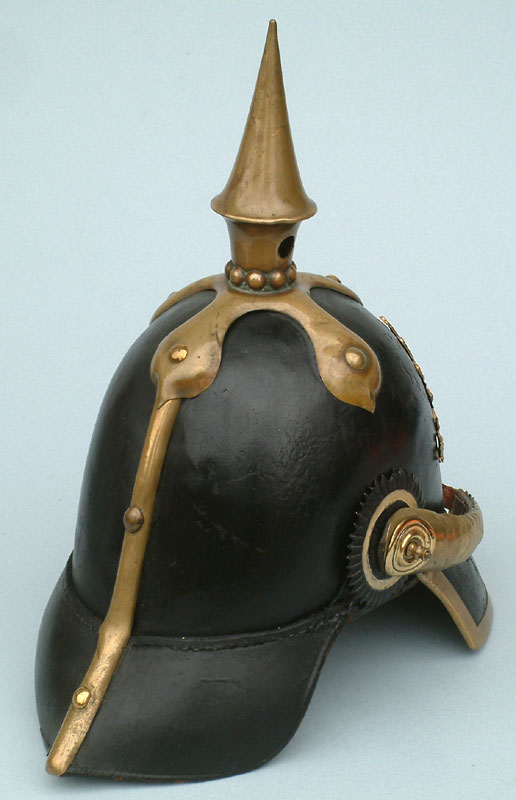 | On the rear of the helmet, a brass spine secured with two brass studs runs from the spike base to the bottom of the rear visor which adds strength and rigidity to the helmet body.
The helmet shell is sewn up the rear and the rear brass spine helps to hide this feature of the construction.
| |
| |
The large convex brass chinscales are secured to the helmet with a 3cm threaded bolt with a brass head.
The heavy brass convex chinscales measure an impressive 36mm wide at the widest point. All troops wore convex chinscales until 1856 when an AKO directed that the convex brass chinscales would be changed to flat brass chinscales for all Infantry units. |  |
|
| |
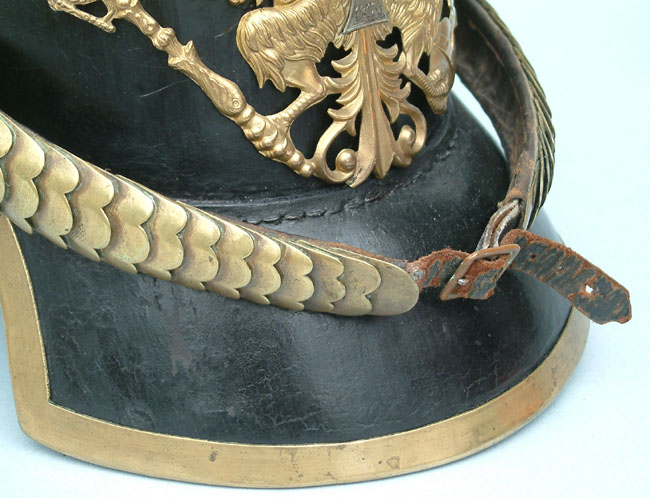 | The chinscales have a small leather strap and buckle sewn into the chinscale backing to keep them together when not worn under the chin.
The chinscales did not hook together on issued M1842 Pickelhaubes, so both ends of the last scale on the chinscales are simply rounded. |
|
The liner of the M1842 Pickelhaube was of heavy leather with rounded "tongues" perforated at the ends for a leather string to adjust the fit. The rear visor has curled inward from the effects of time, unlike the front visor which carries a thick brass trim. Of interest, the rear visor has a sewn leather edge, similar to what is found on the rear visor of Officer Pickelhaubes right up until 1918.
Note that all the brass threaded bolts for securing the brass fittings to the shell are all domed.
| 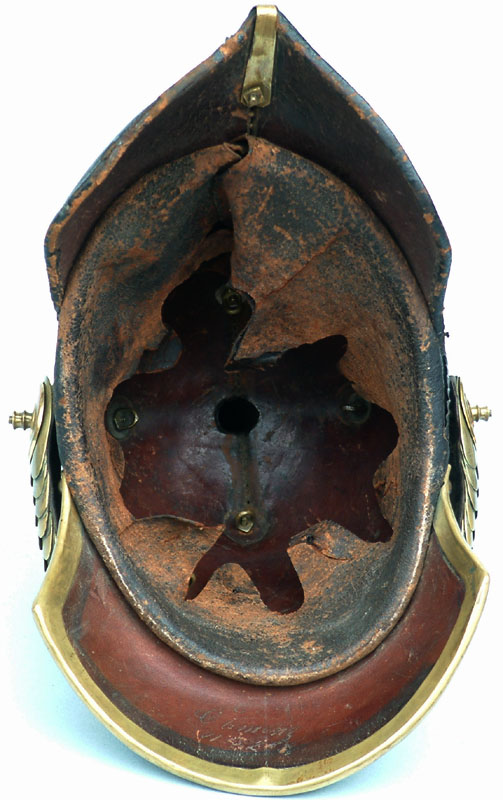 | |
 | An exceptionally rare photograph of a soldier of the Preußen Infantry wearing a Model 1842 Pickelhaube.
The photographer was Atelier (studio) Ernst Fentsch in Neisse. It is signed by what appears to read (?) as : Freiherrn Treusch von Buttlar Brandenfels (?) and annotated that he belonged to Infanterie-Regiment Graf Bose (1. Thüringisches) Nr.31 from Altona.
| |
Although commercial photographs on tin were available from August 1839 by Louis Daguerre as Daguerreotypes, this image was captured as an early Cartes-de-visite which were introduced by Parisian photographer, Andre Disdéri in 1854. Due to the significant changes introduced in the shape of the Pickelhaube between 1857 and 1860, this photograph was probably taken at least prior to 1860, making it the oldest photograph of a Pickelhaube in use that I am aware of.
I am not aware of any other photograph owned or in
print, of an M1842 Pickelhaube being worn.
| 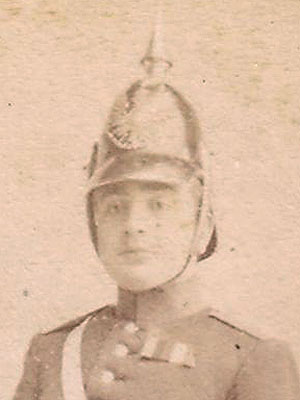 | |
| |
|
 |











